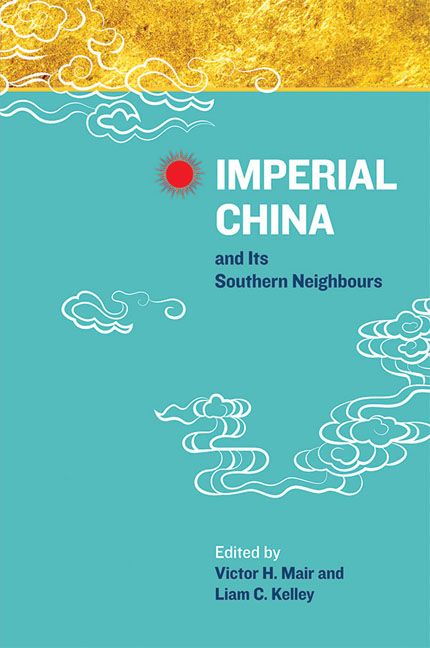Book contents
- Frontmatter
- Contents
- Preface
- The Contributors
- 1 Introduction: Imperial China Looking South
- 2 Layers of Meaning: Hairstyle and Yue Identity in Ancient Chinese Texts
- 3 Sinicization and Barbarization: Ancient State Formation at the Southern Edge of Sinitic Civilization
- 4 Clothes Make the Man: Body Culture and Ethnic Boundaries on the Lingnan Frontier in the Southern Song
- 5 What Makes a Chinese God? or, What Makes a God Chinese?
- 6 Dragon Boats and Serpent Prows: Naval Warfare and the Political Culture of China's Southern Borderlands
- 7 Inventing Traditions in Fifteenth-century Vietnam
- 8 Epidemics, Trade, and Local Worship in Vietnam, Leizhou Peninsula, and Hainan Island
- 9 Southeast Asian Primary Products and their Impact on Chinese Material Culture in the Tenth to Seventeenth Centuries
- 10 New Evidence on the History of Sino'arabic Relations: A Study of Yang Liangyao's Embassy to the Abbasid Caliphate
- 11 The Peacock's Gallbladder: An Example of Tibetan Influence in Late Imperial China
- 12 Transformation of the Yunnanese Community Along the Sino–burma Border During the Nineteenth and Early Twentieth Centuries
- 13 How the North Tried to Pacify the South Through Ritual Practices: On the Origins of the Guan Suo Opera in the Nineteenth Century
- 14 Realms Within Realms of Radiance, or, can Heaven Have Two Sons? Imperial China as Primus Inter Pares among Sino–pacific Mandala Polities
- Index
- Nalanda-Sriwijaya Series
11 - The Peacock's Gallbladder: An Example of Tibetan Influence in Late Imperial China
Published online by Cambridge University Press: 06 January 2018
- Frontmatter
- Contents
- Preface
- The Contributors
- 1 Introduction: Imperial China Looking South
- 2 Layers of Meaning: Hairstyle and Yue Identity in Ancient Chinese Texts
- 3 Sinicization and Barbarization: Ancient State Formation at the Southern Edge of Sinitic Civilization
- 4 Clothes Make the Man: Body Culture and Ethnic Boundaries on the Lingnan Frontier in the Southern Song
- 5 What Makes a Chinese God? or, What Makes a God Chinese?
- 6 Dragon Boats and Serpent Prows: Naval Warfare and the Political Culture of China's Southern Borderlands
- 7 Inventing Traditions in Fifteenth-century Vietnam
- 8 Epidemics, Trade, and Local Worship in Vietnam, Leizhou Peninsula, and Hainan Island
- 9 Southeast Asian Primary Products and their Impact on Chinese Material Culture in the Tenth to Seventeenth Centuries
- 10 New Evidence on the History of Sino'arabic Relations: A Study of Yang Liangyao's Embassy to the Abbasid Caliphate
- 11 The Peacock's Gallbladder: An Example of Tibetan Influence in Late Imperial China
- 12 Transformation of the Yunnanese Community Along the Sino–burma Border During the Nineteenth and Early Twentieth Centuries
- 13 How the North Tried to Pacify the South Through Ritual Practices: On the Origins of the Guan Suo Opera in the Nineteenth Century
- 14 Realms Within Realms of Radiance, or, can Heaven Have Two Sons? Imperial China as Primus Inter Pares among Sino–pacific Mandala Polities
- Index
- Nalanda-Sriwijaya Series
Summary
In the past decades, we have witnessed academic articles and monographs published at an astonishing rate on the cultural interactions between Tibet and China. These studies have tended to focus on the religious ideas and practices influencing the elite class, namely the Tibetan Buddhism that interested the rulers of the Yuan, Ming, and Qing dynasties. Tibetan influence on the popular culture of the Chinese has been largely ignored. This is partly because the Tibetans have never been rulers of the East Asian Heartland. Moreover, for geographic and historical reasons, Tibet was — until the 1950s — a mystical and hermetically enclosed society in the Chinese imagination. It has consequently been believed that Tibetan culture could not have any direct or lasting effect on Chinese society during the imperial period.
This study aims to challenge these assumptions, and to rethink Sino- Tibetan cultural communications from a different perspective. We begin with a survey of the surviving textual records on the usage of the peacock's gallbladder and the image of the peacock, revealing several clues for further exploration. Following these clues, we close in on the origin of the peacock's gallbladder as a lethal poison in the Tibetan culture of medicine and pharmacy. We examine the introduction of Tibetan medicine to China under the Mongol rule, and its tremendous impact on the Mongol elites in the second section of this paper, and focus on the medicinal usage of the peacock's gallbladder recorded in two major works of Tibetan materia medica, namely the rGyud-bZhi and the Shel gong shel phreng, in the third section. Lastly, we discuss the possible Buddhist influence on the reception of the peacock in Tibetan tradition.
The Peacock's Gallbladder and the Peacock in the Chinese Tradition
A pharmacologist would point out that the “peacock's gallbladder”, at least as a poison, simply does not exist: like the gallbladders of many other birds, it is in no sense toxic. Why, then, did this story, so at odds with any kind of fact, survive?
What is the peacock's gallbladder? Can we associate the poisonous mythical “peacock's gallbladder” with the actual gallbladder of a peacock? Alternatively, is the item in question something possessing a fancy name but actually having nothing to do with the peacock? An examination of the history of the myth, especially regarding the cultures that have accepted it, may help answer these questions.
- Type
- Chapter
- Information
- Imperial China and Its Southern Neighbours , pp. 268 - 290Publisher: ISEAS–Yusof Ishak InstitutePrint publication year: 2015

